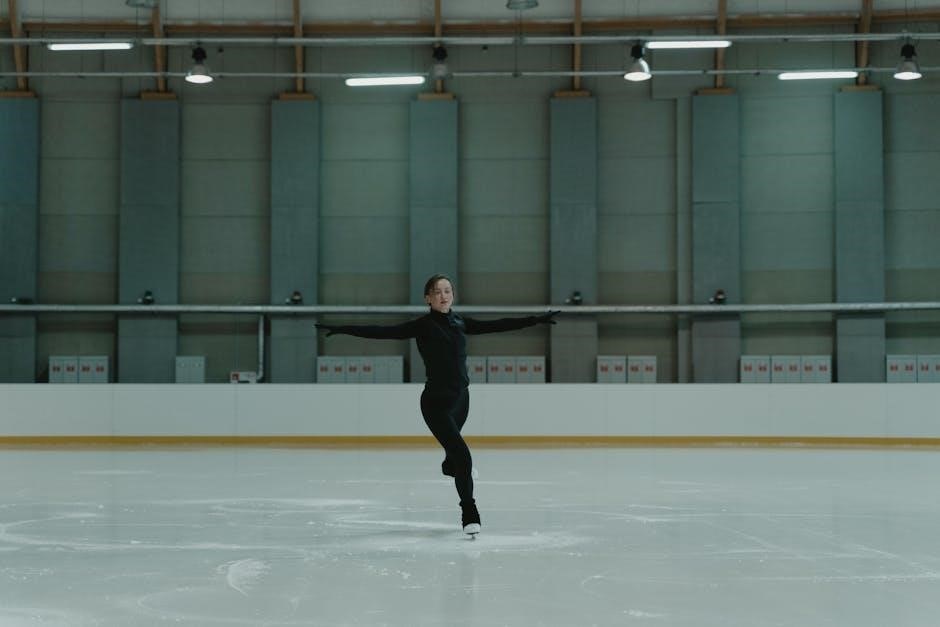tmj dysfunction exercises pdf
- Published
- in PDF
Temporomandibular joint (TMJ) dysfunction affects the jaw joint and surrounding muscles, causing pain, clicking, and limited movement․ It impacts daily activities like chewing and speaking, often linked to muscle tension, misalignment, or inflammation․ Early diagnosis and targeted exercises can significantly improve symptoms and restore jaw function․ Understanding the condition is the first step toward effective management and relief․
1․1 Understanding TMJ Dysfunction
Temporomandibular joint (TMJ) dysfunction refers to a condition where the jaw joint and surrounding muscles experience pain, limited movement, or clicking․ It affects the joint connecting the jawbone to the skull, essential for chewing, speaking, and yawning․ Symptoms often include jaw pain, difficulty opening the mouth, and muscle tension․ Causes may include muscle overactivity, joint inflammation, or misalignment․ Exercises and physical therapy are key treatments, targeting pain relief and restoring proper jaw function․ Understanding the condition is crucial for effective management and preventing further complications․
1․2 Signs and Symptoms of TMJ Dysfunction
Common signs of TMJ dysfunction include jaw pain or tenderness, clicking or popping sounds when opening the mouth, and difficulty chewing․ Limited jaw movement, such as trouble opening the mouth wide, is another symptom․ Headaches, facial pain, and earaches may also occur due to referred pain․ Some individuals experience jaw locking or deviation when speaking or eating․ Muscle tension in the face and temples is frequent, especially in stressful situations․ Symptoms often worsen in the morning or after prolonged jaw use, like chewing or talking․ Early recognition of these signs is crucial for effective management and relief․

Importance of Exercises for TMJ Dysfunction
Exercises play a crucial role in managing TMJ dysfunction by alleviating pain, improving jaw mobility, and correcting muscle imbalances, leading to enhanced oral function and overall well-being․
2․1 Role of Exercise in Managing TMJ Pain
Exercise plays a vital role in managing TMJ pain by reducing muscle tension, improving joint mobility, and strengthening the jaw muscles․ Gentle stretching and strengthening exercises can alleviate pain and discomfort associated with TMJ dysfunction․ Regular exercises help restore proper jaw alignment and reduce inflammation, making it easier to perform daily activities like chewing and speaking; Additionally, exercises promote blood flow to the affected area, enhancing healing and reducing stiffness․ Consistent practice of targeted exercises can significantly improve quality of life for individuals suffering from TMJ pain, making it a cornerstone of long-term management strategies․
2․2 How Exercise Helps Alleviate TMJ Dysfunction
Exercise is a powerful tool for alleviating TMJ dysfunction by addressing both the joint and surrounding muscles․ It helps break the cycle of muscle spasms and pain, improving joint mobility and reducing stiffness․ Strengthening exercises target the muscles around the TMJ, enhancing stability and reducing strain on the joint․ Stretching exercises relieve tightness and restore normal range of motion․ Over time, consistent exercise can reduce inflammation, improve alignment, and prevent recurring issues․ By combining strengthening and stretching techniques, individuals can achieve long-term relief and improve their overall jaw function, making daily activities more comfortable and pain-free․

Types of TMJ Dysfunction Exercises
TMJ dysfunction exercises include stretching, strengthening, and posture training․ These exercises relieve tension, strengthen jaw muscles, and improve alignment, promoting overall jaw health and function effectively․
3․1 Stretching Exercises for TMJ Relief
Stretching exercises are essential for alleviating TMJ dysfunction by reducing muscle tension and improving joint mobility․ These exercises target the jaw, neck, and facial muscles to enhance flexibility and relieve pain․ Techniques include gentle jaw openings, lateral movements, and masseter muscle stretches․ Regular stretching can help reduce stiffness and clicking sensations, promoting smoother jaw function․ It’s important to perform these exercises slowly and within a pain-free range to avoid aggravating the condition․ Consistency is key, as stretching helps restore normal jaw mechanics and prevents further dysfunction․ Over time, these exercises can significantly improve TMJ health and overall comfort․
3․2 Strengthening Exercises for Jaw Muscles
Strengthening exercises for the jaw muscles are crucial for stabilizing the TMJ and improving overall jaw function․ These exercises target the masseter, temporalis, and digastric muscles, which play a key role in jaw movement․ Techniques include jaw clenching, resistance exercises, and isometric holds․ By strengthening these muscles, individuals can achieve better jaw alignment and reduce pain․ It’s important to perform these exercises gently and under professional guidance to avoid overstrain․ Consistency in these exercises can lead to long-term improvement in TMJ function and reduced discomfort․ Strengthening the jaw muscles is a vital component of managing TMJ dysfunction effectively․
3․3 Posture Training and Its Impact on TMJ Health
Posture training plays a significant role in maintaining TMJ health by reducing strain on the jaw joint and surrounding muscles․ Poor posture, such as forward head position or rounded shoulders, can exacerbate TMJ dysfunction by altering the alignment of the jaw․ Exercises like chin tucks, shoulder rolls, and cervical stretches help restore proper spinal alignment․ Strengthening the neck and shoulder muscles also supports the TMJ, preventing unnecessary strain․ Correcting posture can alleviate pain and improve jaw function, making it an essential component of TMJ dysfunction management․ Consistent posture training enhances long-term TMJ health and overall comfort․

Role of Physical Therapy in TMJ Dysfunction
Physical therapy addresses TMJ dysfunction by improving jaw mobility, reducing pain, and enhancing overall joint function․ It combines exercises, manual techniques, and posture correction for lasting relief and prevention․
- Customized programs tailored to individual needs․
- Manual therapy to release tension in jaw muscles․
- Education on proper posture and jaw alignment․
4․1 Benefits of Customized Exercise Programs
Customized exercise programs for TMJ dysfunction offer personalized approaches to address specific symptoms, improving effectiveness and adherence․ They target individual needs, ensuring exercises are tailored to the severity and type of dysfunction․ These programs often combine stretching, strengthening, and posture correction, promoting balanced recovery․ A physical therapist assesses the patient’s condition to design a plan that maximizes progress and minimizes discomfort․ Regular adjustments ensure the program evolves with the patient’s improvement, providing long-term relief and preventing relapse․ This personalized approach enhances recovery efficiency and empowers patients to manage their condition effectively․
- Addresses specific symptoms and severity․
- Combines stretching, strengthening, and posture correction․
- Regularly adjusted to match progress․
- Enhances long-term recovery and prevention․
4․2 Manual Therapy and Mobilization Techniques
Manual therapy and mobilization techniques play a crucial role in managing TMJ dysfunction by enhancing joint mobility and reducing muscle tension․ Techniques such as joint mobilization and soft tissue massage target the TMJ and surrounding muscles, improving range of motion and alleviating pain․ Myofascial release is often used to relax tight facial and jaw muscles, while gentle mobilizations help restore normal joint function․ These hands-on methods, performed by a skilled physical therapist, complement exercise programs and accelerate recovery․ Regular sessions can significantly reduce stiffness and improve bite alignment, offering immediate relief and supporting long-term TMJ health․
- Improves joint mobility and reduces muscle tension․
- Includes techniques like joint mobilization and myofascial release․
- Enhances recovery when combined with exercises․
- Provides immediate and long-term relief․

TMJ Dysfunction Exercises PDF Resources
TMJ dysfunction exercises PDF resources provide structured plans for managing symptoms․ These guides, available on healthcare websites and from specialists, include diagrams and step-by-step instructions for effective relief․
- Offer detailed exercise routines and tips․
- Include visual aids for proper technique․
- Tailored for self-management and professional guidance․
5․1 Where to Find Reliable Exercise Guides
Reliable TMJ dysfunction exercise guides can be found through healthcare providers, orthodontists, or physical therapists․ Websites like the American Dental Association and specialty clinics often provide downloadable PDFs․ Online marketplaces such as Amazon and Google Drive may also offer comprehensive guides․ Ensure the resource is peer-reviewed or endorsed by a medical professional for credibility․ Many PDFs are designed by experts, offering clear instructions and visuals for proper technique․ Always verify the source to avoid unqualified or misleading information․ These guides are invaluable for self-managed care and professional rehabilitation plans, ensuring safe and effective exercise routines․
5․2 Key Features of a Good TMJ Exercise PDF
- Clear instructions and high-quality visual aids to ensure proper technique․
- Exercises based on scientific evidence for maximum effectiveness․
- Customizable routines to accommodate different levels of TMJ dysfunction severity․
- Comprehensive safety guidelines to prevent injury and promote safe practice․
- Expert endorsements or patient testimonials to build trust and credibility․
- Progress tracking features to monitor improvement and maintain user engagement․
These essential features ensure the guide is both effective and user-friendly for managing TMJ dysfunction, providing a reliable resource for those seeking self-managed care․
When to Seek Professional Help
Consult a specialist if experiencing severe pain, limited jaw movement, or persistent symptoms despite self-care․ Professional guidance is crucial for complex or worsening TMJ dysfunction cases․
6․1 Indicators for Consulting a TMJ Specialist
Consult a TMJ specialist if experiencing severe pain, limited jaw movement, or persistent symptoms despite self-care․ Key indicators include difficulty chewing, jaw locking, or clicking, and radiating pain to the ears or temples․ Persistent tenderness in the jaw muscles, frequent headaches, or facial pain warrant professional evaluation․ If TMJ dysfunction disrupts daily activities or sleep, seeking expert help is essential․ A specialist can provide personalized treatment, including advanced therapies or exercises tailored to address underlying issues effectively․ Ignoring severe symptoms may lead to chronic conditions, making early intervention crucial for optimal recovery and long-term jaw health․
6․2 How a Physical Therapist Can Tailor Exercises
A physical therapist specializes in creating personalized exercise plans for TMJ dysfunction, ensuring they address specific symptoms and needs․ They conduct thorough assessments to identify imbalances in jaw alignment, muscle strength, and range of motion․ Customized exercises may include gentle stretching, strengthening, or mobilization techniques tailored to the individual’s condition․ Progress is monitored, and adjustments are made to optimize recovery․ A therapist’s expertise ensures exercises are safe, effective, and progressive, helping patients achieve lasting relief and improved jaw function without risking overuse or injury․

Managing TMJ Pain Through Lifestyle Changes
Adopting a diet rich in anti-inflammatory foods, maintaining proper posture, and practicing stress-reducing activities can significantly alleviate TMJ discomfort and improve overall jaw health effectively․
7․1 Diet and Nutrition Tips for TMJ Health
A balanced diet plays a crucial role in managing TMJ dysfunction․ Incorporating anti-inflammatory foods like leafy greens, berries, and fatty fish can reduce joint inflammation․ Staying hydrated helps maintain joint lubrication, while avoiding hard or chewy foods minimizes jaw strain․ Soft, nutrient-rich foods such as yogurt, scrambled eggs, and cooked vegetables are ideal․ Limiting processed sugars and caffeine, which can exacerbate muscle tension, is also beneficial․ Additionally, consider supplements like omega-3 fatty acids and magnesium to support muscle and joint health․ A mindful eating approach, avoiding chewing gum or ice, further protects the TMJ․ Proper nutrition complements exercises for optimal relief and recovery․
7․2 Stress Management Techniques for TMJ Relief
Stress management is essential for alleviating TMJ dysfunction symptoms, as stress often exacerbates jaw tension․ Techniques like meditation, deep breathing, and yoga can help relax facial and jaw muscles․ Progressive muscle relaxation and mindfulness practices reduce overall stress levels, minimizing TMJ pain․ Journaling and biofeedback therapy can also help identify and manage stress triggers․ Regular stress reduction activities, combined with TMJ exercises, promote long-term relief and improve quality of life․ Consistent practice of these techniques enhances emotional well-being and supports physical recovery from TMJ dysfunction․

Advanced TMJ Dysfunction Exercises
Advanced exercises focus on complex jaw movements and muscle coordination, enhancing stability and strength to restore optimal jaw function and reduce chronic pain effectively․
8․1 Mandibular Stabilization Exercises
Mandibular stabilization exercises aim to improve jaw alignment and function by strengthening the muscles that support the temporomandibular joint․
These advanced exercises often involve controlled clenching, chewing, and opening/closing movements to enhance neuromuscular coordination and reduce instability․
They may include the use of a splint or bite guard to guide proper jaw positioning during practice, ensuring consistent progress․
Regular practice helps alleviate pain, restore balanced jaw movement, and prevent further dysfunction by promoting long-term joint stability and muscle harmony․
Professional guidance is crucial to tailor these exercises to individual needs and avoid overexertion or misalignment during the recovery process․
8․2 Jaw Muscle Awareness and Control Techniques
These exercises focus on enhancing proprioception and voluntary control of the jaw muscles to reduce tension and improve function․
Techniques include gentle jaw movements, such as lateral and protrusive exercises, to promote coordinated muscle activity․
Patients are often taught to identify and release muscle tension through palpation and biofeedback methods․
Control exercises involve precise movements, like opening the mouth with minimal effort, to avoid overloading the TMJ․
Regular practice helps restore balanced muscle activity, reducing pain and improving chewing efficiency․
A physical therapist can tailor these exercises to address specific muscle imbalances and promote long-term jaw stability․

Preventing TMJ Dysfunction Recurrence
Preventing TMJ dysfunction recurrence involves maintaining a consistent exercise routine, avoiding triggers like teeth grinding, and monitoring jaw health to ensure long-term stability and comfort․
9․1 Long-Term Exercise Routine Recommendations
For long-term management, incorporating a daily routine of 10-15 minutes with gentle exercises like jaw stretches, yoga, and resistance exercises is crucial․ These practices strengthen jaw muscles, improve alignment, and reduce strain․ Consistency is key to preventing recurrence․ Gradually increase exercise intensity as comfort allows․ Consulting a physical therapist can help tailor routines to individual needs, ensuring safety and effectiveness․ Regular monitoring of progress and adjustments to the routine are essential for sustained relief and overall jaw health․ Persistence in these practices fosters long-term stability and reduces the likelihood of TMJ dysfunction returning․ A well-structured plan is vital for lasting results․
9․2 Avoiding Habits That Trigger TMJ Issues
To prevent TMJ dysfunction recurrence, identify and avoid habits that strain the jaw․ Jaw clenching, teeth grinding (bruxism), and excessive gum chewing are common triggers․ Avoid biting or chewing hard objects, like ice or nails, as this can misalign the jaw․ Poor posture, especially tilting the head forward, can also exacerbate TMJ issues․ Limit loud or prolonged talking, as this can overwork the jaw muscles․ Becoming mindful of these habits and replacing them with healthier alternatives, such as using a stress ball instead of clenching, can significantly reduce TMJ strain․ Regular breaks during repetitive activities can also help prevent discomfort and long-term damage․

Success Stories and Case Studies
Real-life examples highlight individuals who achieved significant TMJ health improvement through targeted exercises․ These case studies demonstrate the effectiveness of consistent routines in alleviating symptoms and promoting recovery․
10․1 Real-Life Examples of Exercise-Based Recovery
Many individuals have experienced significant improvement in TMJ dysfunction through consistent exercise routines․ For instance, a patient with chronic jaw pain and limited mobility reported a 70% reduction in symptoms after six weeks of targeted exercises․ Another case involved a person who eliminated clicking and locking by practicing jaw stretches and postural corrections regularly․ These real-life examples demonstrate how tailored exercise programs, often detailed in TMJ dysfunction exercises PDF guides, can lead to lasting relief and improved jaw function․ Such successes emphasize the importance of consistency and adherence to prescribed routines for effective recovery․
10․2 The Impact of Consistency in Exercise Programs
Consistency in TMJ dysfunction exercises is crucial for achieving and maintaining progress․ Regular practice strengthens jaw muscles, improves joint mobility, and prevents relapse․ Patients who adhere to daily routines often report faster relief from pain and clicking․ Even short, focused sessions can lead to significant improvements over time․ Individualized plans, such as those found in TMJ dysfunction exercises PDF guides, help ensure sustained commitment․ Without consistency, progress may plateau or reverse, emphasizing the importance of making exercises a long-term habit for optimal TMJ health․

The Future of TMJ Dysfunction Treatment
The future of TMJ dysfunction treatment lies in personalized digital solutions, such as AI-driven exercise apps and VR tools, offering tailored guidance and real-time feedback for optimal recovery․
11․1 Emerging Trends in Exercise Therapy
Emerging trends in TMJ dysfunction exercise therapy include the integration of wearable technology and biofeedback devices to monitor jaw movements and muscle activity in real time․ Telehealth platforms are also gaining popularity, enabling remote consultations and personalized exercise plans․ Additionally, interactive digital tools, such as gamified exercise apps, are being developed to enhance patient engagement and adherence․ These innovations aim to make exercise therapy more accessible, effective, and tailored to individual needs, promoting better outcomes for TMJ dysfunction management․ Such advancements are reshaping the approach to exercise-based treatments, offering patients more convenient and dynamic solutions․
11․2 The Role of Technology in TMJ Exercise Programs
Technology is revolutionizing TMJ exercise programs by enhancing precision, accessibility, and engagement․ Mobile apps and software now offer personalized exercise plans based on individual needs, tracking progress and providing real-time feedback․ Virtual reality (VR) tools are being explored to simulate exercises, improving adherence and understanding․ Additionally, AI-powered devices can analyze jaw movements and muscle tension, offering corrections to optimize therapy․ These advancements enable patients to perform exercises more effectively, with greater convenience, and under guided supervision․ Technology is thus transforming TMJ exercise programs into smarter, patient-centric solutions for long-term management and recovery․
Proper TMJ dysfunction exercises, supported by physical therapy and lifestyle changes, are essential for managing symptoms and preventing recurrence․ Consistency and patience are key to achieving long-term relief․
12․1 Summary of Key Points
TMJ dysfunction exercises play a crucial role in alleviating symptoms and improving jaw function․ Stretching, strengthening, and posture exercises are essential for relief․ Consistency in performing these exercises, along with lifestyle changes like proper diet and stress management, is vital for long-term recovery․ Avoiding harmful habits, such as teeth grinding or poor posture, can prevent recurrence․ Professional guidance from physical therapists ensures customized programs tailored to individual needs․ By combining these strategies, individuals can effectively manage TMJ dysfunction and achieve sustainable improvement in their jaw health and overall well-being․ Regular practice and patience are key to overcoming this condition․
12․2 Encouragement for Long-Term Management
Managing TMJ dysfunction requires commitment and patience, but the benefits of long-term care far outweigh the challenges․ Consistent practice of exercises, paired with lifestyle adjustments, can lead to significant symptom relief and improved jaw function․ Embrace the journey as an investment in your health, knowing that small, steady efforts yield lasting results․ Remember, recovery is a process, and every step forward is a victory․ Stay motivated, and celebrate progress, no matter how small․ Your dedication to managing TMJ dysfunction will empower you to regain control and enjoy a pain-free, healthy lifestyle․
